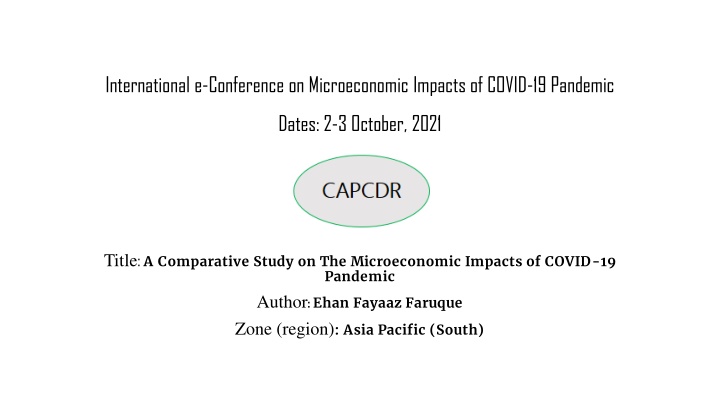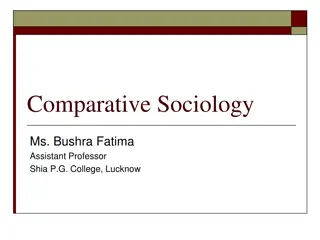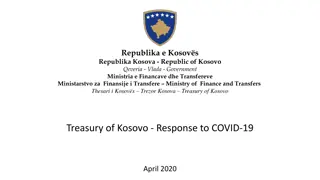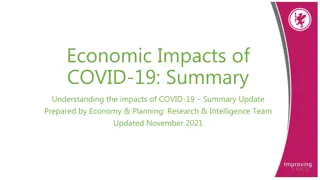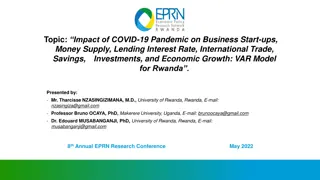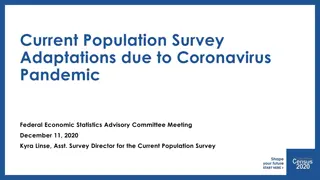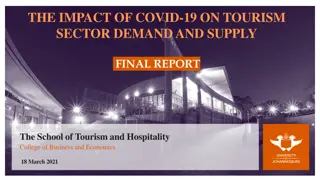Comparative Study on Microeconomic Impacts of COVID-19 Pandemic
This study delves into the effects of the COVID-19 pandemic on microeconomics, analyzing changes in decision-making and welfare maximization among market entities. It explores statistical tools to interpret primary data, examines global policy responses to economic struggles, and evaluates the uncertainties faced by market entities. The research aims to understand the implications of pandemics on individual coping mechanisms and the global economy in modern times, offering insights into how entities adapt to health crises.
Download Presentation

Please find below an Image/Link to download the presentation.
The content on the website is provided AS IS for your information and personal use only. It may not be sold, licensed, or shared on other websites without obtaining consent from the author.If you encounter any issues during the download, it is possible that the publisher has removed the file from their server.
You are allowed to download the files provided on this website for personal or commercial use, subject to the condition that they are used lawfully. All files are the property of their respective owners.
The content on the website is provided AS IS for your information and personal use only. It may not be sold, licensed, or shared on other websites without obtaining consent from the author.
E N D
Presentation Transcript
International e-Conference on Microeconomic Impacts of COVID-19 Pandemic Dates: 2-3 October, 2021 Title: A Comparative Study on The Microeconomic Impacts of COVID-19 Pandemic Author: Ehan Fayaaz Faruque Zone (region): Asia Pacific (South)
Introduction On 31stDecember 2019, the Wuhan City of China was stunned by the outbreak of an infectious disease. In short time, this disease spread globally and had a significant negative impact on the world economy. This disease was named the COVID-19. Economists were submerged with questions on the ways in which the pandemic has affected and is likely to take a toll on the national and global economy. More importantly, how the decisions made and actions taken by entities existing in the market will be changed. Until recently, there had been very little quantitative testing on the microeconomic impacts of the COVID-19 pandemic. However, the pandemic did have numerous effects such as a rise in scarcity of goods and increased demand for products that were short in supply. In this perspective, this paper examines the differences in the choices made by individual agents (consumers, households, and firms) and how their actions changed with the arrival of COVID. Outbreak of the pandemic Unemployment, Price Fluctuations, and etc. Impacts on Market Entities
To analyze the changes in the decision-making mechanisms and the way entities in a market tend to maximize their welfare, this study implemented both qualitative and quantitative testing with the help of statistical tools and also interpreted primary data that interprets the significant changes. Further, this paper schemes through a variety of ways by which the global economy struggled and also the policies implemented by countries to fight the microeconomic impacts of the pandemic. To attain this purpose, crude statistics are employed, a brief definition of microeconomic concepts are mentioned and examples are provided for a comprehensive understanding of the topic. Accordingly, the effects also vary in length as some are only short- term and some long-term. Further, the unprecedented crisis also jeopardized many achievements in the global economy-many falling in the micro sector.
Objectives To understand the microeconomic impacts of pandemics and the recent outbreak of the COVID-19. To analyze how entities are affected with changed decision making. To interpret the effects on consumers and producers of an unprecedented health crisis using statistical tools and measures. To examine the effects of reduced international trade on demand and supply. To determine the factors that lead to uncertainties amongst entities existing in a market. This careful and detailed study relating to the particular concern of the affects of the pandemic on the global economy attempts to illustrate and find how individuals cope with outbreaks especially in the modern day. Besides its in-depth analysis of information, this study creates space for generating new questions, concepts and understandings. However, queries will vary from person to person.
Research Methodology Both primary and secondary sources form a significant portion of the data provided in the study. Primary sources: In this research a cross sectional survey was conducted amongst producers and consumers in a market and data s were extracted from firms listed in the stock market. The survey conducted represented a questionnaire that enabled one to remain anonymous and be open ended. This aims to capture a more accurate and reliable opinion from the respondents. It is important to mention that the collection of primary data was done randomly. On the other hand, secondary sources were collected through articles, online media and interviews done by others. The variables were mostly concerned with decision making and both independent and dependent variables were implemented to develop the hypothesis.
Literature Review And Hypothesis Development The study referred to the following case studies: Case I: John E. Ataguba (April 2020) proposed in the study COVID-19 Pandemic, a War to be Won: Understanding its Economic Implications that the inception of the Coronavirus disease has led to growing concerns and uncertainties. Furthermore, the study referred to Africa in order to determine the microeconomic impacts the region has to deal with post covid. The study summarized that Africa has seen a reduced level of transactions, leading to reduced demand for goods in the market. Hence, production has fallen and it is the underlying problem of uncertainty to blame. Reduced transactions Reduced production Uncertainty Reduced demand
Case II: Oyinlola Abodunrin, Gbolahan Oloye, Bola Adesola (March 2020) Justified in the study Coronavirus Pandemic And Its Implications On Global Economy that aside from being a health issue, COVID-19 had a thorough impact on all levels of the society and market. A major impact of the pandemic is that it reduces the supply of labor in the market, which contributed to the abatement of production. Overall, this microeconomic impact has also facilitated the unprecedented freefall of the components of aggregate demand. Case III: Alexander A. Auzan (April 2020) Found through conducting the study The Economy Under The Pandemic And Afterwards that despite the global economic crisis being undertaken by a shock because of the pandemic, globalization has come to a stoop end. Meaning, export and import has been reduced to a whole new extent, which was not seen since the early times of the Industrial Revolution(1760). As a result, the reduced level of international trade has minimized production and the microeconomy sector has been shaken. Moreover, firms and forces in the market have begun becoming more dependent on the government s financial interventions. Hence, the way producers, consumers, or any individual makes decisions in the market in the future will be quite different from the recent past and their approaches to investments will be unalike.
Microeconomic Impacts According to Literature Review 5 4.5 4 3.5 3 2.5 2 1.5 1 0.5 0 Trade Price Decision Making Compeition The extent to which the pandemic has impacted four major categories have been analyzed and rated on a scale of 0 to 5
Data Representation Undoubtedly, since 2020 the stock market has seen big shifts. Primarily, low investment and reduced level of expenditure is responsible for this change. However, trade between companies and consumers is also something that needs to be considered. Post COVID, trading(including exports and imports) done by companies have plunged, this may also add to the cause behind the reduction in stock trading. The table above demonstrates the reduction in share trading that took place in four companies. For unbiased analysis, the names of the companies have been kept anonymous. However, each company has seen a reduction in trade of more than ten percent of its usual.
One of the biggest microeconomic impacts of any pandemic is the reduction in profits earned by firms. As discussed earlier, due to increased consumer uncertainty, expenditure in the market has reduced. But to what extent has the reduction taken place? The statistical tool above is employed to demonstrate the reduction in profit earned by four firms. Each firm had a reduction of approximately 20% or more in their total profits earned. On average, the business entities say profits have decreased by 25% since the inception of the pandemic.
One factor from which the other microeconomic impacts originate is the reduction in consumer certainty. This factor deals with the level of uncertainty that consumers have in a period for which their expenditure in the market abates. To analyze the repercussions of low consumer expenditure in depth, some economic conditions and results need to be first thought of. In a market, if there subsists less expenditure, it implies that the level of economic activity, meaning trade is low. Hence, aggregate demand will contract and the price level of goods in the economy will reduce. Because the pandemic has made it harder for entities to trade internationally, reduction in national demand means reduced gross demand for them as there exists no other factors in the global economy which can increase the demand for their goods. So, this reduced price level reduces firms' motivation to increase their output and as a result of the low level of willingness and ability to acquire goods in the economy, firms tend to decrease their supply. All these originate from low consumer certainty and hence this microeconomic impact worsens the economy by different means.
Need For The Study For years, economists and researchers were concerned about the economic impacts of a pandemic-more so a pandemic in the modern day-and it has been a prevailing issue for individuals in an economy to ponder upon. However, what was often overlooked was the microeconomic impacts of a pandemic and how entities existing in a market would be affected by it. This study, looks over the overlooked and tries to conclude the means by which the microeconomy is affected by a pandemic, especially in this digital era.
Limitations of The Study While this study does take into account a number of impacts that the pandemic had on the microeconomic sector of the economy, it is safe to assume that there still exists a number of impacts which are not mentioned because of its insignificant nature and little effect on the economy. As a result, it can be inferred that this study has potential limitations. The data interpretations and case studies provided are based on interventional and prospective observational studies. Hence, they may be subject to biases and confounding which may have influenced the conclusions and estimates. The empirical results reported herein should be considered in the light of some limitations; nonetheless, carrying out surveys across the world can be an alternative methodology which can abate the limitations presented.
Research Design Note: This project is based on exploratory as well as descriptive study. The descriptive research presented is carried out to report about the microeconomic impacts of the pandemic in depth, and the exploratory study is presented to clarify and define the most suitable reasoning behind the causes of the impacts. Overall, exploratory studies have been used as a means of gaining ideas and insights to the topic and descriptive research to come to a conclusion. The uses of the exploratory studies came in the form of first formulating the topic for further investigation; then, building the appropriate hypothesis; next, setting priorities for furthering the research; finally, rising familiarity with the topic and coming to a justified conclusion. On the other hand, descriptive research was also used to come to a justifiable conclusion.
Summary of Finding There is prevailing evidence to suggest that the pandemic-COVID-19- had numerous microeconomic impacts. A significantly indirectly proportional relationship between expenditure and uncertainty exists in economies. Safety is a major factor considered before making investments. Low investment can harm entities in an economy. Crises can have adverse effects on the way decisions are made in the economy.
Gross outputs of firms reduce with underlying uncertainty. Profits and income reduce which reduce trade in an economy. Safety of investing on investment schemes plays a big role while individuals invest in a market, and during the pandemic this factor of safety decreases to the extent where entities feel discouraged to employ their funds in the market. Due to fall in income in large, demand for goods in an economy abated, which fluctuated price and hence the overall production in the economy. As the crisis prolongs, entities in the market tend to find ways by which they can return to their original state and increase their chances of making profits and income.
Suggestion Covid-19 will reshape our world. We don t yet know when the crisis will end. But we can be sure that by the time it does, our world will look very different. --Josep Borrell (High Representative of the European Union for Foreign Affairs and Security Policy) The covid-19 pandemic is undoubtedly an unexpected torment for the global economy. This prevailing health crisis had numerous effects on our economy; however, it is important that entities pick themselves up and determine how to battle this crisis alongside being able to grow further. Moreover, it can be construed that hard times dawns on the economy on a frequent basis and even though prolonged, entities existing in the economy should prepare themselves accordingly.
Conclusion After the analysis and interpretation of data it is concluded that the major microeconomic impacts faced by economies post COVID (or any other pandemic) are: underlying uncertainty, reduction in demand and supply, constant fluctuation in price, reduced profits and income earned by producers and consumers in the market, changes in share trading. All these merge to play a significantly large role when it comes to the extent to which the microeconomic impacts vary in an economy. Moreover, the effects of each impact differ, which is essential to mention.
